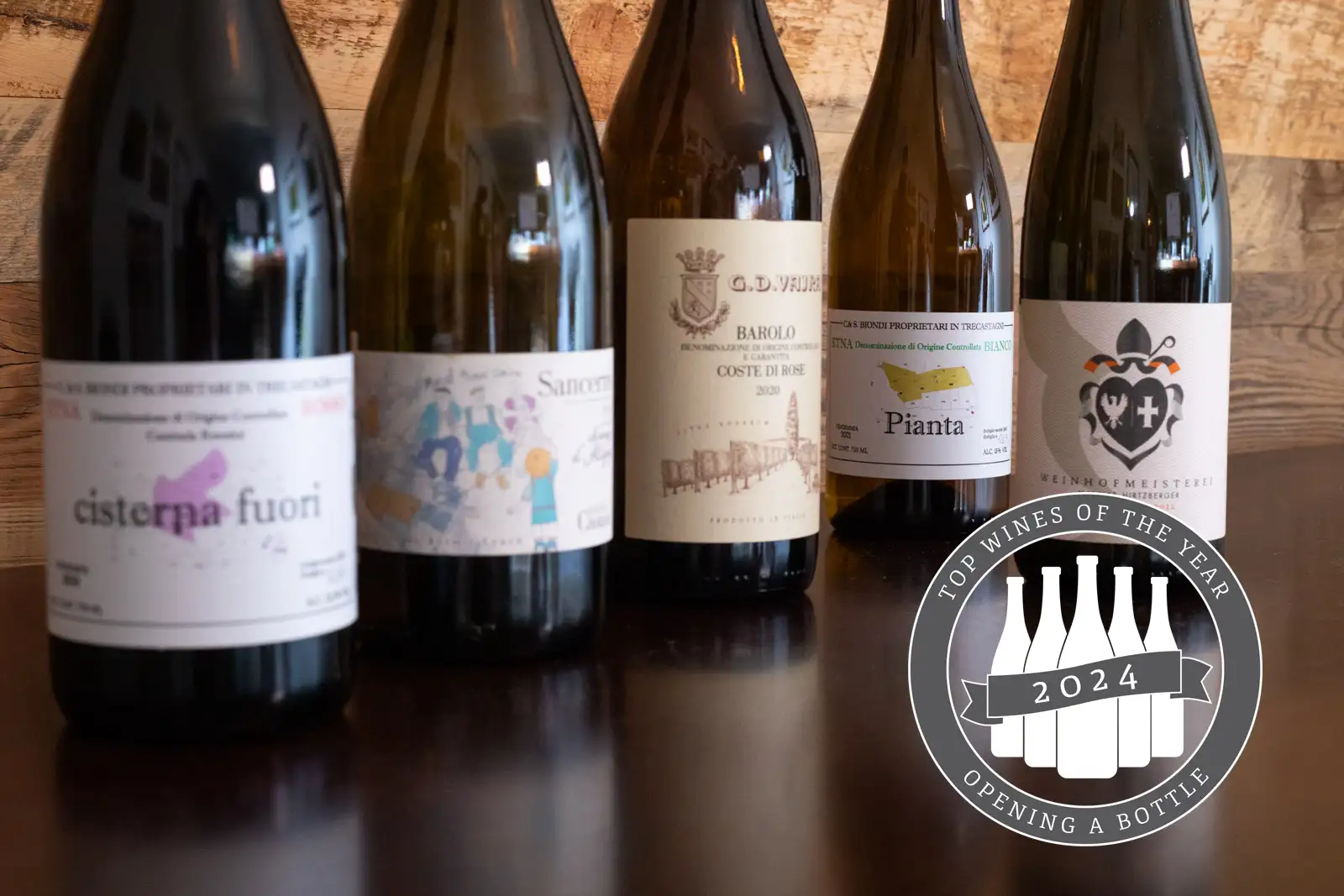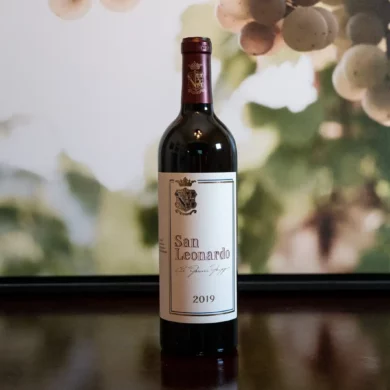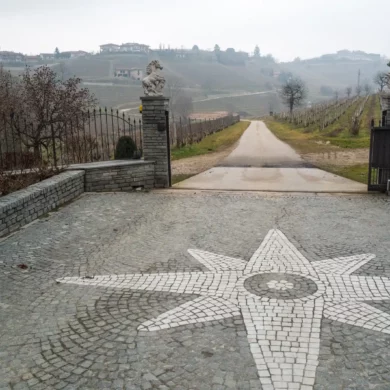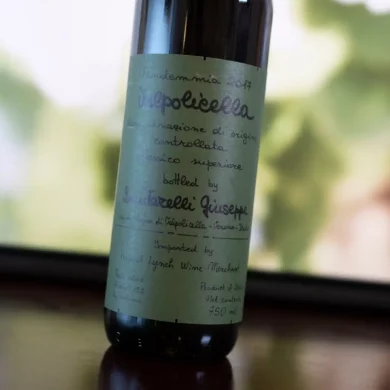It’s time to put a bow on the 2024 a full month after other wine publications have done the same. This year’s mixed case of the Top 12 wines of 2024 just couldn’t help itself: despite my efforts to populate it with five white wines, five red wines, a sparkling wine and either a rosé or an orange wine, the white wines dominated my heart. I simply could not exclude any of the seven listed below.
White Wine’s Moment
Much of this has to do with the times we are in: lower alcohol continues to loom large in many of our buying decisions, as does a desire for freshness over power. I’m 45 years old, so I feel shitty faster, and I’m not so keen on anything at 14.5% ABV or up because of it.
But something else is going on now. The familiar white wine grapes we thought we knew — your Riesling, your Sauvignon Blanc, and yes, even your Pinot Grigio — are now showcasing terroir and technique as well as they ever have. And native white-wine grapes, particularly in Italy, are garnering the research and support they’ve long deserved, unleashing them from the sameness of reduction-heavy practices of the past. No wine better demonstrates this than Etna Bianco, but I nearly listed a Pecorino from Marche, a Nascetta from Piedmont, a Fiano from Campania and an Albana from Emilia-Romagna. This year made for very compelling drinking on the white wine front.
Join Opening a Bottle
- Discover the best wineries in Italy and France
- Read annual reports on Italy’s top appellations
- Watch video classes on wine regions
- Attend online events and discussions
- Have fun while reading about wine (yes, it’s possible)
- Unlock the paywall
Winemaker of the Year: Ciro Biondi
This also marks the first time that a producer crowns my list at No. 1 for a second time, and the first time since I shifted to a smaller top 12 list that a single producer has earned two spots. In both cases, it is the inimitable Ciro Biondi of Mount Etna’s Azienda Agricola Biondi.
In 2021, his beautiful Etna Rosso named “San Nicolo'” topped my list. It stopped me in my tracks with its wild, untamed ways, but also the fine-wine agenda it stuck to: it felt like “a volcano rolling out the welcome mat” I wrote, which having revisited San Nicolo’ several times since, still feels true. Biondi always shows an exceptional craft at allow his wines to be a bit unexpected, but never flawed.
This year, I finally got to meet Ciro and visit his winery on the south side of the Sicilian volcano. What transpired there was nothing short of extraordinary: revelation after revelation after revelation. He is one of Italy’s very best winemakers, yet few know of him like they know Benanti or Passopisciaro, or like they know G.D. Vajra (also listed), Bartolo Mascarello or that “other Biondi,” Biondi-Santi. But he belongs in the conversation.
Next year, I will be publishing my first book on Italian wine, and he’ll be a central figure in the Mount Etna chapter.
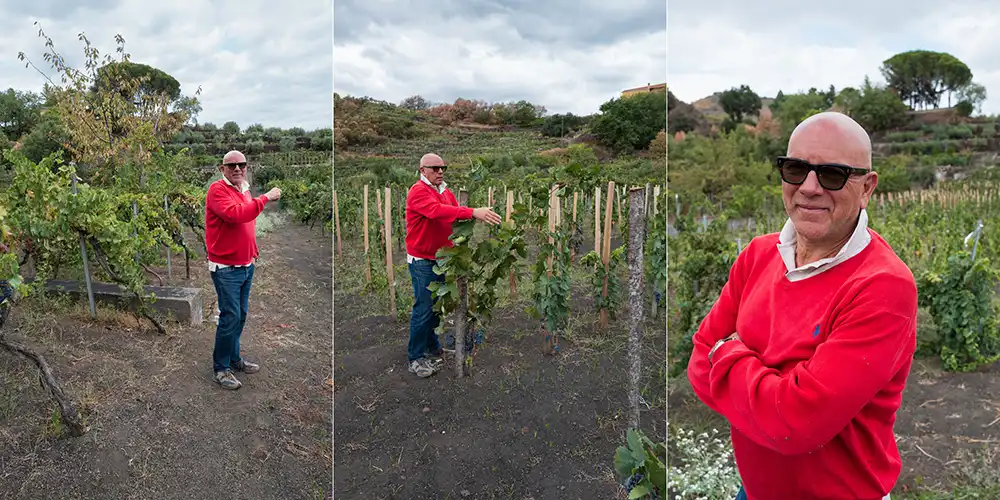
So why list two of his wines? Well, the conceit of this year-end recap is a fantasy mixed case of the year’s highlights. If all of these wines I tasted from mid-December to now were in a single wine shop, there is no doubt in my mind that Ciro’s “Pianta” Etna Bianco would be the first in the box, and that I wouldn’t be able to leave that store without “Cisterna Fuori,” his exotically aromatic Etna Rosso, too. The heart wants what the heart wants.
Without any more delay, the list.
- 2022 Venica & Venica “Jesera” Collio Pinot Grigio
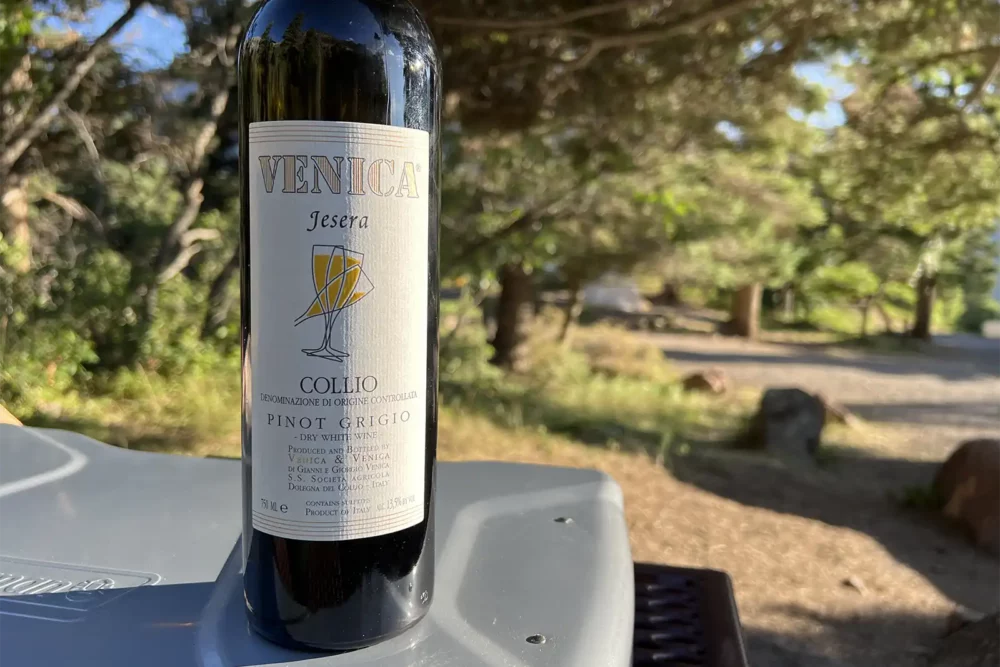
The Refuter, Part 1
Yes, that is a Pinot Grigio starting us off, and yes, it is perched on a closed Coleman stove at a National Forest campground in Southwestern Colorado. What this white wine showed me in July was a determined bulldog spirit that would astonish Pinot Grigio’s detractors. I get it: this grape usually sucks, but in the Collio of Italy’s Friuli-Venezia Giulia, it is fawned over like its Pinot Noir, and the best producers — like Venica & Venica — reward us with conjured memories of tangerine, herbal tea and flowers.
The 2022 “Jesera” overcame the circumstances of my crappy camp stemware and less-than-perfect serving conditions to wow me with its personality. I’ve met its maker, Giampaolo Venica, and this fits his smiling but tenacious personality perfectly. I’ve long admired this wine, and when I saw it on a shelf in Telluride earlier that day, I thought “safe bet.” But I never expected it to show as beautifully as it did at the campsite.
American Importer: Giuliana Imports and Bourget Imports
Wine Industry Group Subscriptions
- Five different log-ins for staff.
- Your own brand page to connect with our readers and aggregate articles in one place.
- The ability to make a paywall article free to the public.
- Discounts on royalty-free photography
- Reward the hard work that goes into this publication.
- 2022 Luberri “Zuri” Rioja Blanco
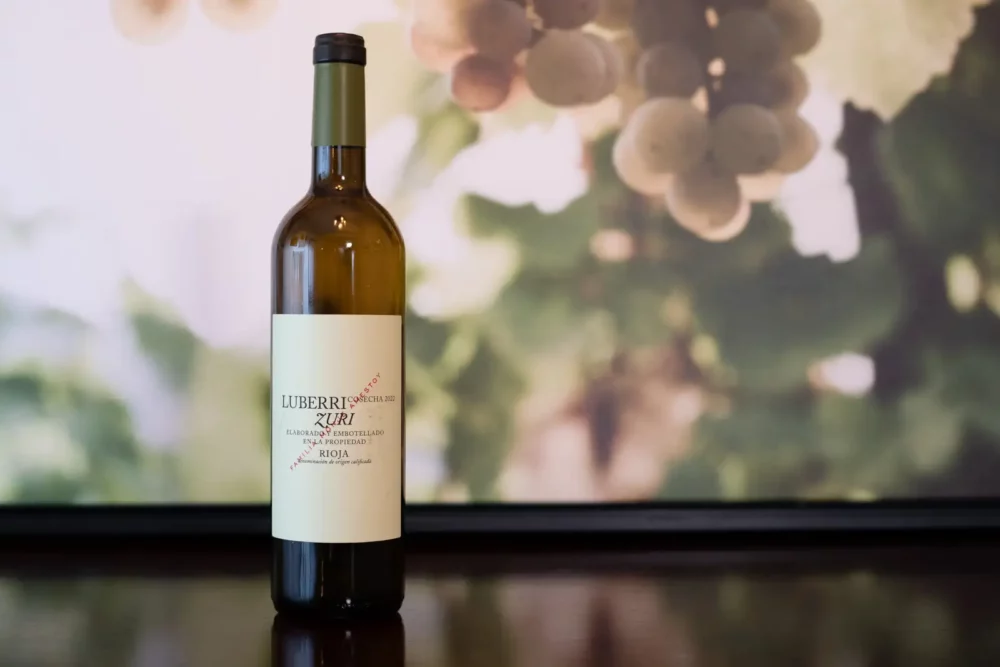
The Refuter, Part 2
If you’d told me last December that next year’s mixed case would include a wine predominantly made from Viura, I would have been surprised, but not stunned. I’d like to think that I know better now than to assume anything about any particular wine grape in the world, yet my database of tasting notes tells a tale of consistent misfires from white Rioja, where Viura often finds a home. Was I due for a mental correction?
I was. Let’s label Luberri’s 2022 “Zuri” Rioja Blanco as the second wine of the year to refute an old premise. This wine was delightfully autolytic, meaning it spent some quality time bathing in the lees after fermentation, creating an aromatic kinship with roasted nuts, as well as a caressing texture on the palate. Bright fruits resembling apricot and apple balanced out the wine beautifully. Look for more Spanish wine coverage next year, as we open up some new avenues (stay tuned).
American Importer: de Maison Selections
- 2019 Danilo Thomain Valle d’Aosta Enfer d’Arvier
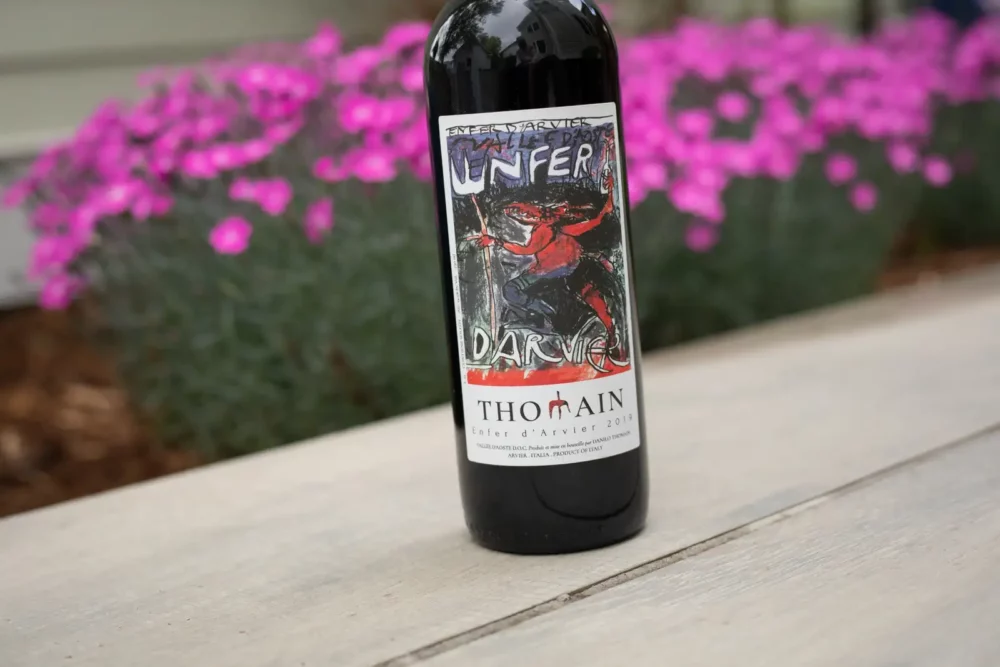
The Brisk Weather Red
If you have this wine on hand, you can tell your friends “we’re drinking a bottle of wine from hell tonight.” The Enfer d’Arvier — literally, the Inferno of Arvier — is one of Italy’s most impossible vineyards, located several folds down the mountain from Mont Blanc in a pocket of the Valle d’Aosta that can only ripen grapes because it is essentially a solar-trap of rocks. Petit Rouge is the lead grape here, and in the hands of the inferno’s only estate bottler, Danilo Thomain, it asserts a towering stature that somehow encapsulates Pinot Noir’s earthy berries as well as the sweet wood-smoke tone of a brisk autumn day.
Everyone loves a good story, and this mysterious wine behind a punk-rock label is a doozy.
American Importer: Rosenthal Wine Merchant
- 2022 Cavallotto “Pinner” Vino Bianco
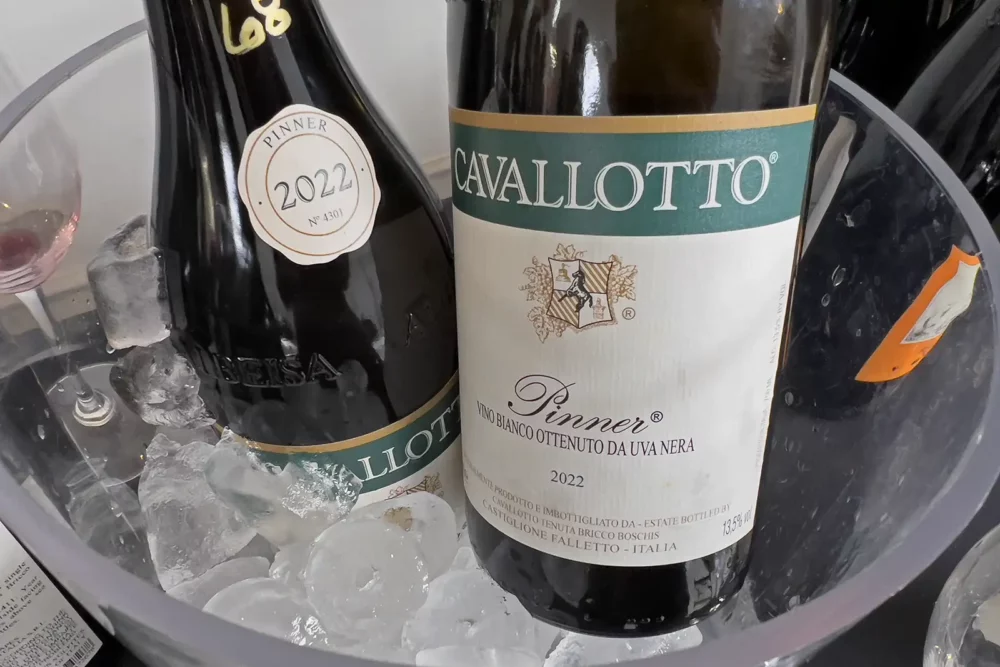
The Unforgettable Pinot Noir
Years and years ago when I was finding my footing in the wine writing cyberspace, I wrote about a still Blanc de Pinot Noir from Oregon by recalling how I used to leave the crust when eating a sandwich as a kid. “But that’s the best part,” my father would always say, pointing at the innocuous ribbon on my plate.
Now as a sensible middle-aged man, I think of this memory whenever someone ditches the skins of Pinot Noir to make a white wine. Why would you, in essence, ditch the best part of the grape, the very lining that beholds the earthy, fruity, herbaceous qualities that makes Pinot Noir, Pinot Noir? Well, the answer lies in Barolo.
Cavallotto’s 2022 “Pinner” is such a contrarian in how it defies fashion, and common sense really. It is made from a Pinot Noir clone adopted in Champagne, where blanc de noir is the name of the game anyway. And it was planted in 1972 in the tiny Barolo cru of Vignolo, where the calcareous marl soils foster a bold sense of texture. Incredibly, this very French wine on paper tastes like Piedmont, with delicate sage-like aromas framing it beautifully.
American Importer: Skurnik, Giuliana Imports and Oliver McCrum
- 2022 Weinhofmeisterei Ried Kollmitz Wachau Riesling Smaragd
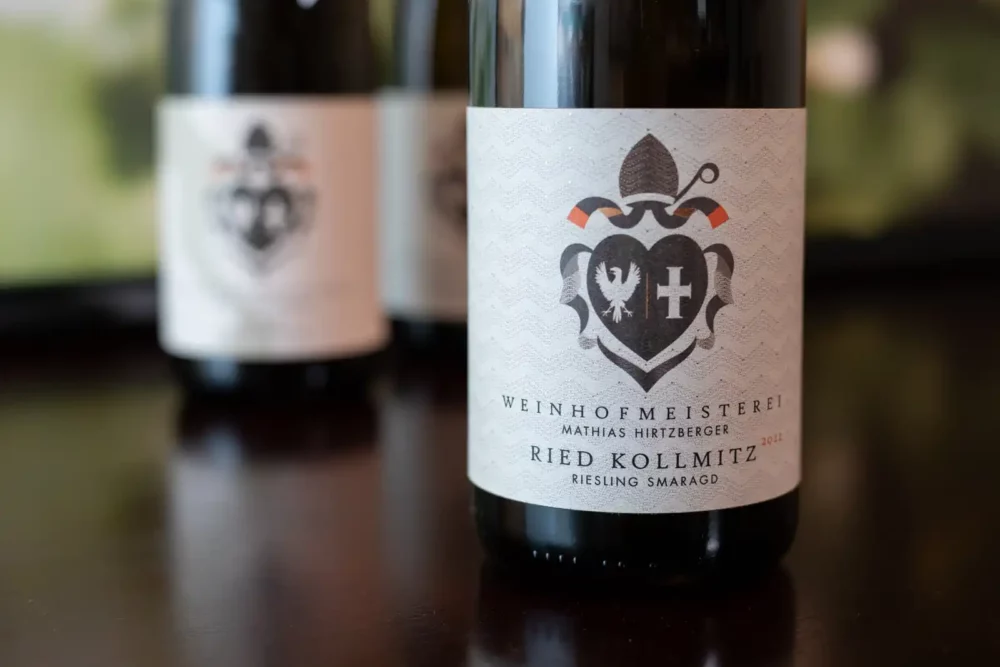
The Classic
Every mixed case needs a classic, and this year, I’m selecting a Wachau Riesling that showcased Austria’s most famous terroir in the most flattering of ways.
Mathias Hirtzberger’s 2022 Weinhofmeisterei Ried Kollmitz comes from a high-elevation vineyard; a place so battered by the wind and cold that harvest sometimes doesn’t happen until the first week of November. Its polar opposite is Hirtzberger’s equally pristine Ried Bach, which I tasted at the same time. In these two wines, I finally saw the Wachau’s ability to transmit terroir with Riesling’s dials of golden-apple, lime-zest and cream recollections all spun to various levels. Ried Bach was far more opulent due to its warmer microclimate, but it was the way Ried Kollmitz inspired the senses — making me think of colors instead of flavors — and did so with the most focused of textures, that I found most inspiring.
American Importer: Weygandt-Metzler
- NV Jacques Lassaigne “Les Vignes de Montgueux” Champagne Blanc de Blanc Extra Brut
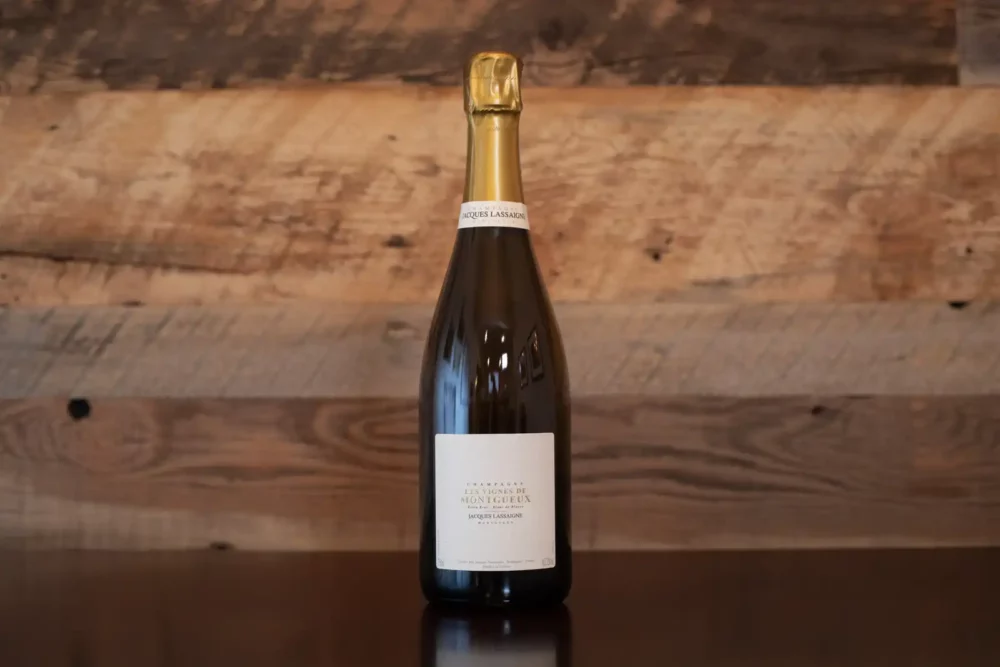
The Artisan for All Occasions
I have an article coming out soon on “grower champagne,” a loosely used term for producers who grow their own grapes and make their own wine in the most vaunted sparkling-wine region in the world. The terms has real marketing caché, but like the traditional vs. modern divide in Barolo, it is beginning to feel antiquated and imprecise as numerous négociant houses have taken to buying vineyards of their own, and as growers have turned to some négociant contracts to stay agile in this tempestuous age of climate change.
However, what makes the idea of grower champagne so vivid and vital, and which ultimately will continue to inspire us, is the idea of artisanal winemaking behind it, which is perfectly embodied by “Les Vignes de Montegueux” from Jacques Lassaigne, a Blanc de Blanc Champagne that reads on the palate like an open invitation to a flavor party. Orchard fruit and the autolytic notes of bread are compulsory with champagne, but here was a wine with heaps of citrus, flowers, creaminess and a pleasantly bitter-edge of hazelnuts. I was eager to see where it was going, but then it was all gone. That happens when the best champagne you’ve tasted in years turns you into a glutton.
One more thing: this wine is disgorged by hand, as all wines at Jacques Lassaigne are. Now that, is the work of an artisan, regardless of the fact that this “grower” is registered and labeled as a négociant manipulant (NM).
American Importer: Jenny & Francois Selections and Old World Wine Co.
- 2020 Azienda Agricola Biondi “Cisterna Fuori” Etna Rosso
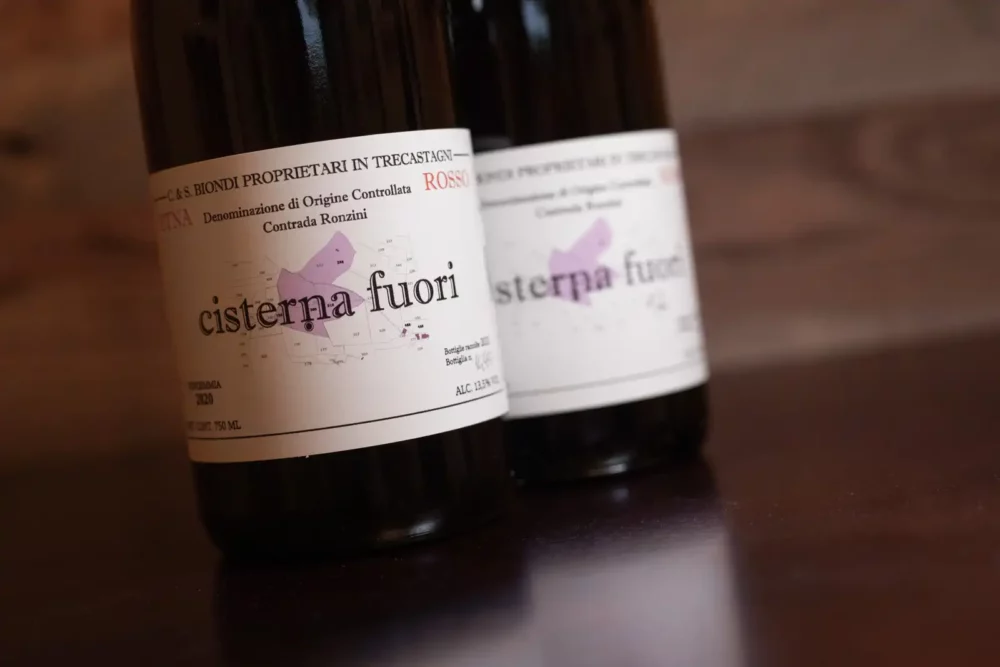
The Evocative Red Wine
The most compelling wines always have contradiction lying beneath the surface. It is a quality that goes beyond just “tension,” and instead reveals something very human: personality. We are all riddled with contradiction ourselves, and it often makes us more interesting.
Ciro Biondi’s 2020 “Cisterna Fuori” is an Etna Rosso whose flavor profile, palate sensations and overall demeanor are rife with such dichotomy. It is immediately generous and open, yet structured in a way that entices you toward its future state; you can tell that it has some unpacking to do, some stories to tell, some wild parties to throw. What does this mean on a technical level? Hard to say, but for me, the natural lightness of this 80% Nerello Mascalese, 20% Nerello Cappuccio wine was beautifully countered in 2020 by a significant tannic grip. But even here, the tannins were not on “assault” mode. (Biondi wouldn’t stand for that; he is far too easy going, and his wines beautifully reflect that). Instead, they were substantial yet supportive; the overall mood of generosity: preserved.
The Cisterna Fuori vineyard lies across the road from Biondi’s San Nicolo’ vineyard, which yielded 2021’s top wine. The former lies in a miniature volcanic basin which last erupted in 125 BCE. The latter is a rounded volcanic cone with a steep pitch. Over the last two years at Etna Days, I’ve gotten to know these two personalities better, and traipsing through their volcanic sand this September was an experience that grayed my shoes and piqued my curiosity further. Their sister vineyard, Chianta, lies uphill and yields a white wine of such sublimity that it is No. 1 this year. And for Christmas, I gifted to myself a mixed half case of all three wines. (Such a Dad move, right? Buying his own gift!). All three wines are a “must have.”
American Importer: Oliver McCrum and Selected Estates of Europe
Gift Subscriptions
Do you have a wine lover on your gift list, but don’t know which wine to buy them? Feed their endless curiosity for wine with a subscription to Opening a Bottle instead.
- 2022 Daniel Chotard “Cuvée Marcel Henri” Sancerre
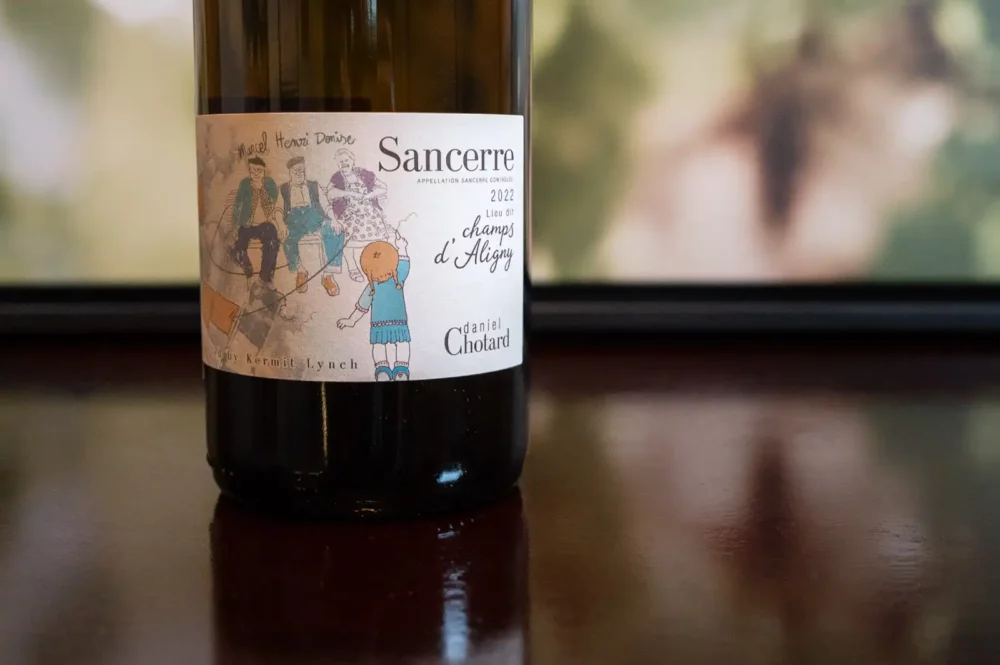
The Switch Hitter
“Oh God,” the long-time reader might say. “Here he goes again with the baseball analogies.”
The funny thing is, I’m not much of a baseball fan, but the sport’s obsession with batting averages and batting orders sure does come in handy when describing how I look at wine. For one thing, the best wines are still living beings, and as a result, they have tiny variations from vintage to vintage, and even bottle to bottle within the same year. Once you accept that, you can develop a fondness for certain producers not because you expect them to hit home runs at every at-bat, but because they consistently keep the inning going. In short, they get on base (Moneyball: it is a great movie).
Secondly, like any dugout manager, I celebrate versatility as much as anything, and I love a true switch hitter — a batter (i.e. wine) who can hit left-handed or right-handed depending on whose pitching (i.e. whose cooking and what they are cooking).
As far as “leagues” that foster talent go, Sancerre can be a bit all over the place, yielding a lot of aspirational home-run hitters whose at-bats amount to little more than a boring, exhausted pitch count (“my God, this metaphor is going on forever”). But in Daniel Chotard’s dynamic 2022 “Cuvée Marcel Henri” Sancerre, I found a Sauvignon Blanc that is as exciting and versatile as Shohei Ohtani (Ok, I’ll stop). Its vivid aromas stopped me in my tracks, offering beautiful memories of stone-fruit, cardamom spice and blue flowers, while its silky palate presence and generous mineral finish indicated a wine that was up for any food pairing or occasion I wanted to present to it. You can steal a lot of bases with this wine (“He didn’t stop”).
Sancerre is often disregarded by many wine professionals because is often the go-to order of unadventurous drinkers looking to merely check a “French white wine” box. But it can be joyful. Extremely joyful. The wines of Daniel Chotard, especially this one, proved that to me this year.
Note: The name of this wine is a bit hidden, with “Lieu-dit Champs d’Aligny” being the most prominent mark on the front of the label. Online retailers will have it listed as “Cuvée Marcel Henri.”
American Importer: Kermit Lynch Wine Merchant
- 2022 Tesselaarsdal Hemel-en-Aarde Ridge Chardonnay
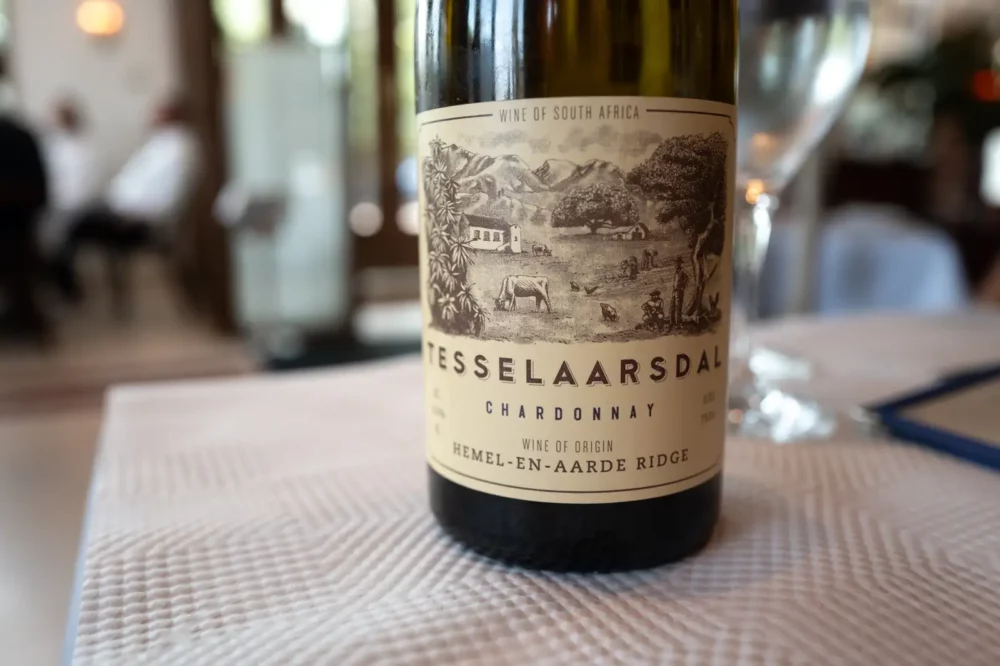
The Unforgettable Chardonnay
Opening a Bottle has long been focused on Italian wines first and foremost, with French wines a close second. I prefer to cover wine with depth, and these are the two areas that I’ve devoted my studies and travels to. I’ll admit that beyond those spheres, my expertise level is just curiosity.
But of course, I know Chardonnay and Pinot Noir, and I know what I want from it: a wine that can still convey a great story with its familiarity. When I was invited to meet entrepreneurial winemaker Berene Sauls of the South African winery Tesselaarsdal, that curiosity dial was turned up to 11.
Wine is often just the paper that a compelling human story is printed on, but in Berene’s case, her compelling tale was complemented by one of the finest Chardonnay wines I’ve had in years. It showcases the cool climate brilliantly of the evocatively named Hemel-en-Aarde Ridge (“heaven and earth”), as well as purity of the “blank canvas grape” when it is raised mostly in amphorae with a little neutral oak. I won’t bore you with aromatic and taste descriptors, because this wine is all about feeling, which — coming from a winemaker with such exceptional personal intuition and daring — feels ever-so-appropriate.
American Importer: Vineyard Brands
- 2021 Istine “Vigna Casanova dell’Aia” Chianti Classico Gran Selezione
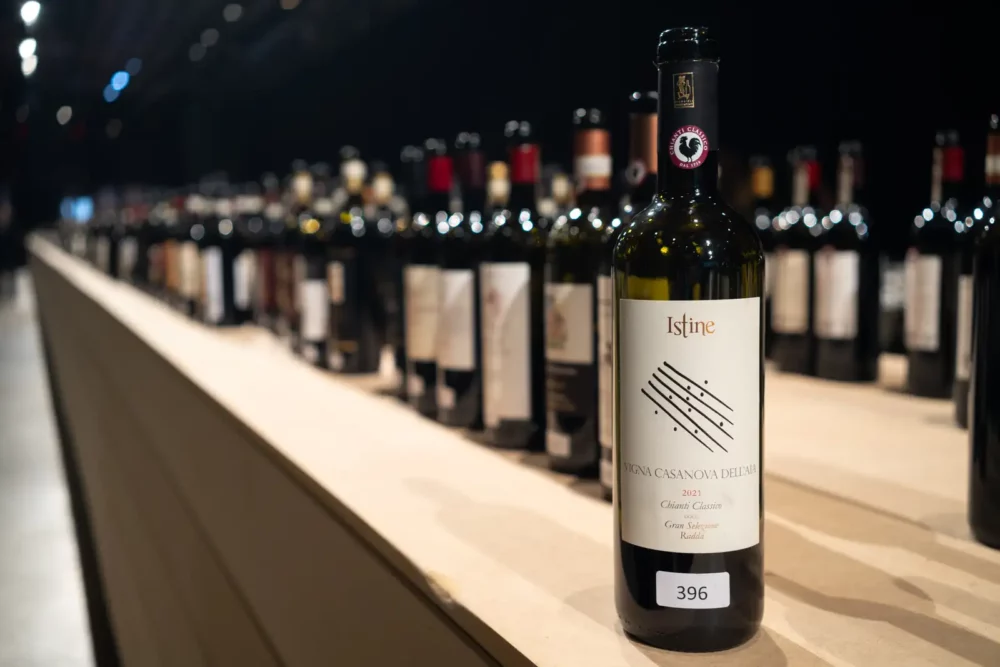
The Vanguard Sangiovese
More than any other grape this year, I tasted Sangiovese. I tasted it as a rosato, I tasted it as a spumante, and I certainly tasted it as a still red wine over and over and over again, from the depths of winter to the heights of summer. In fact, after a whole week of tasting it at the Anteprima di Toscana in February, you’d think I was made of Sangiovese. And you’d also likely think that it would all blur together, but that is certainly not the case with Chianti Classico, which is right now on a Taylor Swift-like era of prolific, manifold hits. Wines from Piemaggio, Monteraponi, Castell’in Villa, I Fabbri, Castello di Monsanto, Nittardi and of course, sleeper sensation Villa Calcinaia, all vied for my attention with their different expressions of what peak of Sangiovese.
But it was Angela Fronti’s Istine that felt most at the vanguard about what “New Chianti Classico” is all about. I could reinvent the wheel here with my description of her new Gran Selezione, the 2021 Vigna Casanova dell’Aia, but the original review in my tasting report from that day says exactly how I remember it:
[It] is everything I love about Chianti Classico: dashing splashes of fruit augmented by peppercorn-savory and light botanical elements, a line of sharp-orange citrus-like acidity to keep things moving, and an overall disposition that recalls the mountains and forests of its rugged landscape. This wine tastes like its from somewhere, and that somewhere is a place you want to be when you taste the wine. All the while, it is as supple and elegant as most anything you could pour from Barolo, Burgundy or Sonoma.
Those two days tasting Chianti Classico in Firenze’s Stazione Leopolda were monumental, exciting and educational. I look forward to returning again in 2025.
American Importer: Oliver McCrum and SoilAir Selection
- 2020 G.D. Vajra Barolo Coste di Rose
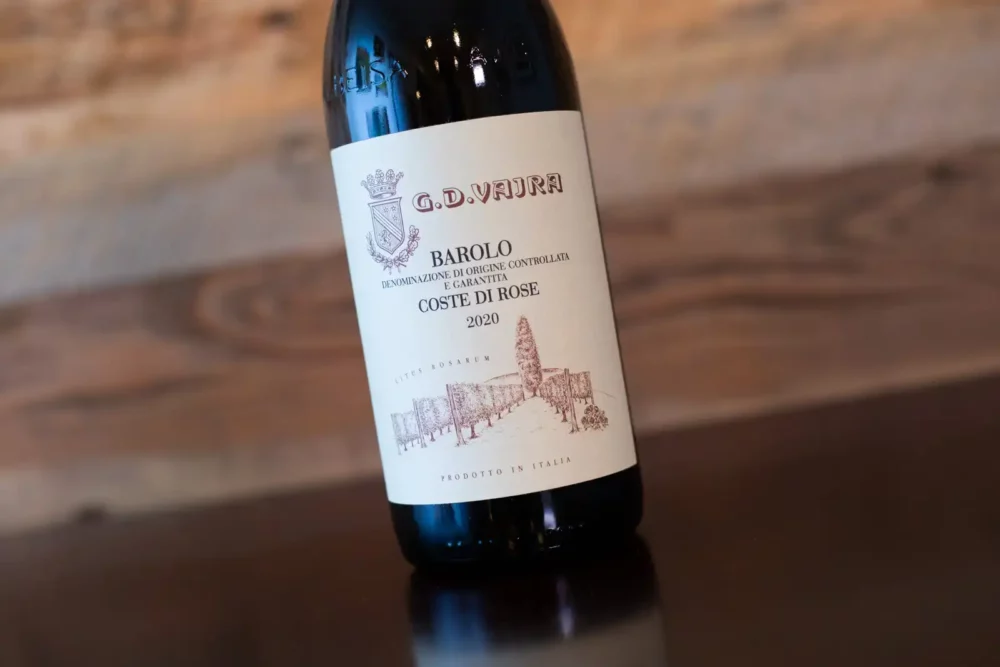
The One for the Cellar
Writing about G.D. Vajra here in December of 2024 feels a little premature for me, since I have a visit to the estate slated on my calendar for February 3 of next year. But in March, I attended a compelling virtual seminar with Giuseppe Vajra that was arranged for the media by his public relations agency. We were sent a fleet of samples, as is par for the course with these events, and while I often open just one and save the others for when I’m alone and can think, something about Vajra’s disarming demeanor — which transmitted right through Zoom — made me pop some corks on a random Thursday morning.
I should set the stage a bit more: G.D. Vajra is not only one of Piedmont’s greatest family wineries, it is one of the world’s greatest family wineries. Everything they do — from the not-so-simple Rosabella rosé to their astonishing Nebbiolo wines — strives for a level of refinement and graciousness that is damn near impossible to achieve on a warming planet. Yet there were glimpses — just glimpses — into the psyche of the family on that call, like when Vajra talked about how cooler temperatures reduce the flight time for bees in the vineyard, and how the size of the petals during bud-break determine the eventual size of the grape’s berries. This was punctuated by turns of phrase (“Ravera’s soil looks like a lasagna”) and a demeanor that matches the easy grace I’ve always found in these wines.
Yet it is in Barolo, and the single-vineyard cru wines, where G.D. Vajra shows its command and mastery of Italy’s most complex character, Nebbiolo. The Bricco delle Viole MGA is so closely associated with Vajra that they feel one and the same, and indeed the 2020 is a monumental wine. Similarly, the Ravera MGA is marked by the power and grace that the vineyard is known for. Yet I was most taken by the wine from the Coste di Rose MGA — a small, little-known vineyard next to the village of Barolo that in 2020 produced one of the most elegant, bountiful Barolo wines I’ve ever tasted. The aromas alone are worth the price of this wine (around $80), a magnificent swirl of suggestions ranging from black raspberries and sage leaf to leather and mushrooms. “You have two feet in the Langhe and they are nowhere else” I wrote in my notes. What more could a Barolo lover want?
American Importer: Giuliana Imports and Beaune Imports
- 2021 Azienda Agricola Biondi “Pianta” Etna Bianco
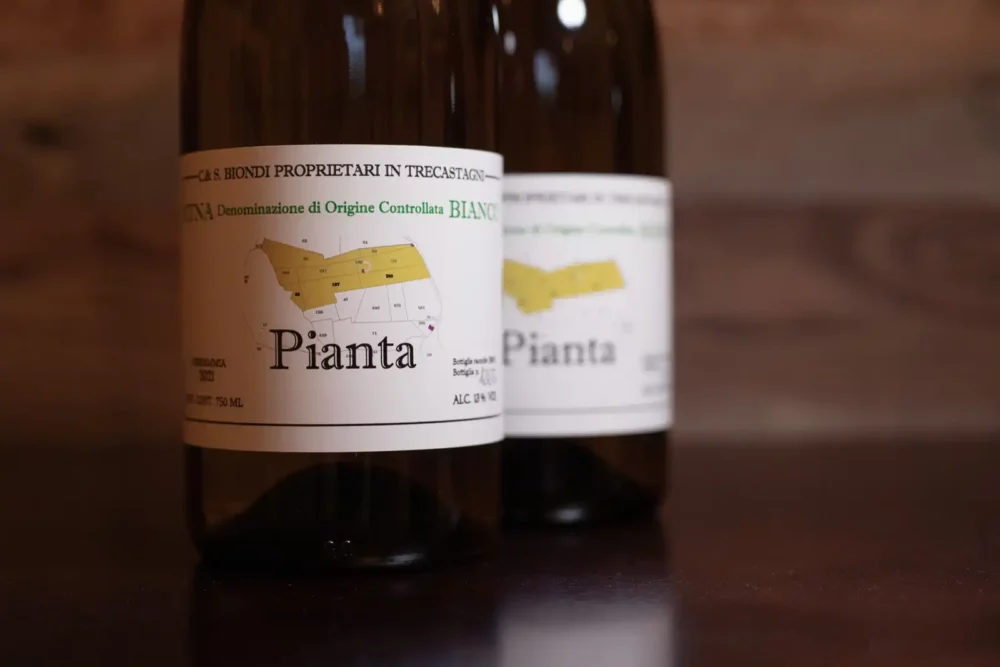
The New Standard for White Wine
As I pressed my face to the airplane window glass and watched Mount Etna slip into the haze of Sicily this past September, I thought about what lay ahead of me. I’d spent a week stomping around its ashy slopes researching for several writing projects, namely a book that is coming next year, as well as three tasting reports on Etna Bianco, Etna Rosso, and Etna Rosato and Spumante wines, and revisions to some existing profiles and guides.
But I also felt like there was a three-word headline to encompass the experience: Etna Bianco Reigns.
This wine has been ascendent for some time, but at wineries such as Benanti, Monteleone, I Custodi delle Vigne dell’Etna, Tenuta di Fessina, Barone di Villagrande, Cottanera, Palmento Costanzo and many more, this magical, shape-shifting white wine seem to make a declaration to me: I am not only here to stay, I am the new standard.
For some wine lovers, the gold standard in white wine is Chablis. For others, it is the white wines of the Côte de Beaune. Few others show up in the conversation.
While I adore those wines with all my heart as well, Etna Bianco is my new benchmark because of its personality and wild character, which always seems tied to the volcanic, high-elevation terroir. The best Etna Bianco allow for The Delightfully Unexpected, and that is a quality the wine world should celebrate more.
The wine that best captured this spirit was, once again, one from Ciro Biondi. His 2021 “Pianta” Etna Bianco hails from a vineyard named Chianta on the southeast slope of the volcano where the soil is ashy, dusty and loose, and where the vines rise up one side like a staircase into the Mediterranean sky.
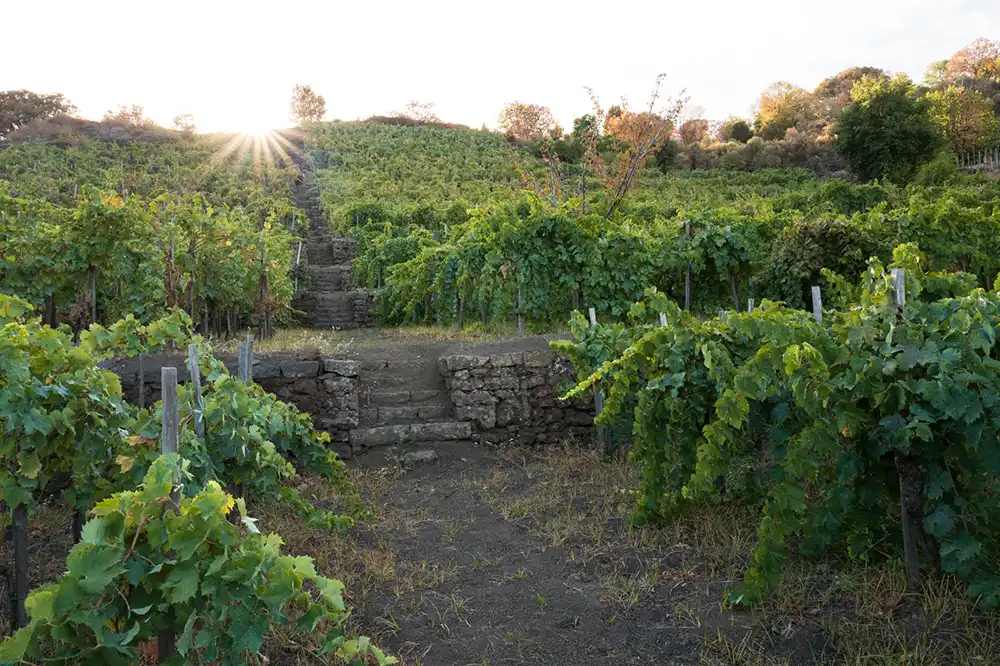
But before I had even walked amidst the vines, I’d tasted the 2021. It makes a powerful first impression, with a solar character that feels dramatically different than the justly celebrated Etna Bianco Superiore from the eastern slope around Milo. One might think Maconnais vs. Chablis in this comparison, and on a basic level, that works to explain what’s happening: the former is more forward and substantial, the latter more mysterious and lean. But that analogy falls apart because of the succulent nature of Pianta’s acidity, and the way its complex core — pear, fresh mint, lemon-orange citrus, dash of salt — seems to invite other sensations in that I never knew existed. For me, this is the magic of volcanic wine: its unpredictability. Don’t confuse it with unreliability or a lack of focus. Think of it as a story whose plot-twists are unexpected but perfectly appropriate.
That’s a pretty high bar to clear for the world’s white wines, but producers like Ciro Biondi are quietly setting it.
American Importer: Oliver McCrum and Selected Estates of Europe
Share in the Passion
This publication has been going for more than 10 years, fueled almost entirely by a passion for wines of distinct character. You made it this far in the list, so you get it. Share in this passion by becoming a paid subscriber for just $79/year, and unlock the entire site and all of its in-depth profiles.
Note: Learn more about our editorial policy on samples and wine travel.

